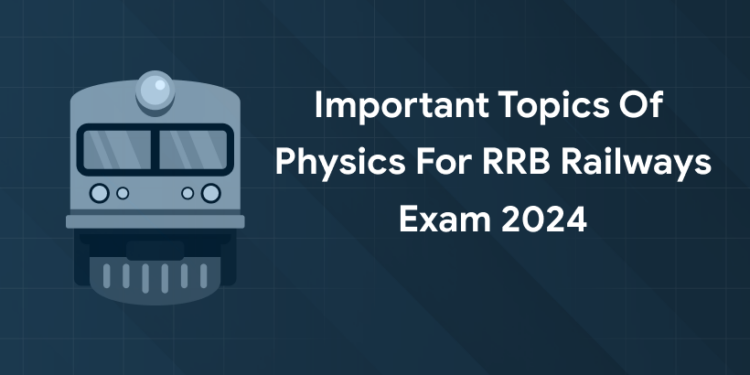Railway jobs in India are one of the most appreciated and demanding Jobs. Every year, Ministry of Railway announces lakhs of vacancies for various posts such as Locomotor Driver, Non Technical Popular Category (NTPC Posts), Station Master (ASM), Ticket Collector (TC), Gangman, Various Group D Posts, ITI, Apprentice,Paramedical, Medical Officer, Specialists and Others. In this blog we will discuss about Important Topics of Physics For RRB Railways Exam.
Indian Railways has published the recruitment notification to the post of Apprentice, Doctor, Paramedical Posts under Northeast Railway, Central Railway, and South East Central Railway. More than 5000 vacancies are available under Railway Recruitment 2024.
Indian Railways is one of the world’s largest Rail Network always has an attracting scope of career for youth with its lucrative job profiles and a list of perquisites only railway employees can avail. Various regional units of Indian Railway’s has invited applications for the recruitment to the posts such as Group C, Group D, This year, Railway Recruitment Board of the country showered the young Indians with some great Railway job opportunities across the country.
Keeping the upcoming RRB NTPC, RRB Group D, in mind, we have provided some Important Physics Notes in this blog. It will help you boost up your score in the upcoming RRB Railways Exam.
Important Topics of Physics For RRB: Basic Topics of Physics
Work
Work is said to be done, if force acting on a body is able to actually move it through some distance in the direction of the force. Its SI unit is a joule.
Energy
Energy is a scalar quantity and its unit is Joule.The sum of all kinds of energies in an isolated system remains constant at all times. This is the law of conservation of energy.
Power
Its unit is watt.
• 1 watt hour = 3600 Joule
• 1 kilowatt hour = 3.6 x 106
joule
• 1HP = 746 watt
Gravitation
Everybody in the universe attracts other body by a force called force of gravitation.
• The gravitational force of the earth is called gravity.
• The acceleration produced in a body due to force of gravity is called acceleration due to gravity (g) and its value is 9.8 m/s’
• Acceleration due to gravity is independent of shape,size and mass of the body.
• Escape velocity is the minimum velocity with, which an object just crosses the Earth’s gravitational field and never returns. Escape velocity at the Earth’s surface is 11.2 km/s.
• Escape velocity at the Moon’s surface is 2.4 km/s. Due to low escape velocity there is no atmosphere on the moon.
• Value of g decreases with height or depth from Earth surface.
• g is maximum at poles.
• g is minimum at equator.
• g decreases due to rotation of Earth.
• g decreases if angular speed of Earth increases and increases if angular speed of Earth decreases.
• The acceleration due to gravity at the moon is onesixth that of the Earth. So, the weight of a person on the surface of the moon will be 1/6 of his actual weight on the Earth.
Satellite
Satellites are natural or artificial bodies revolving around a planet under its gravitational force of attraction.
• Moon is a natural satellite, while INSAT-B is an artificial satellite of Earth.
• The period of revolution of satellite revolving near the surface of earth is 1 hour 24 minutes (34 minutes).
• Geo-stationary satellite revolves around the Earth at a height 36000 km (approx).
• Time period of rotation of geo-stationary satellite is 24 hours.
• The Earth rotates on its axis from West to East. This rotation makes the Sun and the stars appear to be moving across the sky from East to West.
• A geosynchronous satellite is a satellite in geosynchronous orbit, with an orbital period the same as the Earth’s rotation period.
• A special case of geosynchronous satellite is the geostationary satellite, which has a geostationary orbit – a circular geosynchronous orbit directly above the Earth’s equator.
• Geo-stationary satellite is used to telecast. TV programmes from one part of the world to another, in weather forecasting, in predictions of floods and droughts.
• Polar Satellite Revolves around the earth in polar orbit at a height of 800km.
Newton’s Law of Motion
First Law: Everybody maintains its initial state of rest or motion with uniform speed on a straight line unless an external force acts on it. It is also called Galileo’s law or law of inertia. Example While jumping from a slowly moving train/bus one must run for short distance, in the direction of motion.
• Second Law: The form acting on an object is directly proportioned to the product of the mass of the object and the acceleration produced on it.
• Third Law: To every action, there is an equal and opposite reaction.Example : Bogies of the trains are provided with buffers to avoid severe jerks during shunting of trains.
Rocket moves up due to reaction of downward ejection of gas.
Circular Motion
• When an object moves along a circular path, its motion is called circular motion.
• The external force required to act radially inward over the circular motion of the body is called Centripetal force.
• Centrifugal force is such a pseudo force that. is equal and opposite to Centripetal force.
• Cream separator, centrifugal dryer work on the principle of centrifugal force.
Friction
• In the opposing force that is set-up between the surfaces of contact, when one body slides or rolls or tends to do so on the surface of another body.
• Due to friction, we are able to move on the surface of Earth.
• While applying brakes in automobiles, it stops only due to friction.
Pascal’s Law of Pressure
•Hydraulic lift, hydraulic press and hydraulic brakes are based on the Pascal’s law of pressure.
Archimedes Principle
• When a body is immersed partly or wholly in a liquid,there is an apparent loss in the weight of the body,which is equal to the weight of liquid displaced by the body.
• The weight of water displaced by an iron ball is less than its own weight. Whereas water displaced by the immersed portion of a ship is equal to its weight. So,small ball of iron ball sink in water, but large ship float.
• A fat person will quickly learn the swimming as compared to a slim person because he will displace more water. So, it will be more balanced.
• Hydrogen filled balloon float in air because hydrogen is lighter than air. A person can lift more weight in water.
Important Topics of Physics For RRB: Some Conversion Factors
Mass and Density
• 1 Kg = 1000 g = 6.02 u
• 1 Slug = 14.6 kg
• 1 u = 1.66 kg
Length and Volume
• 1 m = 100 cm = 39.4 inch = 3.28 ft
• 1 mile = 1.61 km = 5280 ft
• 1 inch = 2.54 cm
• 1 nm = m = 10 A
• 1 pm = m = 1000 fm
• 1 light year = 9.46 m
• 1 = 1000 L = 35.3 = 264 gal
Angular Measure
• 1 m/s = 3.28 ft/ s = 2.24 mi / h
• 1 km / h = 0.621 mi / h = 0.278 m/s
Force and Pressure
• 1 lb = 4.45 N
• 1 ton = 2000 lb
• 1 Pa = 1 N/ = 10 dyne/ = 1.45 lb/
• 1 atm = 1.01 x 105 Pa = 14.7 lb/ = 76 cm – Hg
Be a Loco Pilot in Indian Railways!
Some Important Scientific Instruments
• Accumulator: Electrical energy is stored
• Altimeter: Used in aircraft for measuring altitudes
• Ammeter: Measuring the electrical current in amperes
• Anemometer: Measuring the strength of winds
• Audiometer: Measuring intensity of wind
• Audiophone: It is used for improving imperfect sense of hearing.
• Barometer: Measuring atmospheric pressure
• Binocular: An optical instrument designed for magnified view of distant objects by both eyes simultaneously
• Bolometer: To measure heat radiation
• Cardiogram: For recording the heart movements
• Calorimeter: Measuring of quantities of heat
• Chronometer: A clock that keeps very accurate time as the one that is used to determine longitude at sea.
• Colorimeter: An instrument for comparing intensities of colour.
• Commutator: An instrument to change or remove the direction of an electric current, in dynamo used to convert
alternating current into direct current.
• Cyclotron: Studying the properties of atoms by smashing them.
• Dynamo: A device for converting mechanical energy into electrical energy
• Dynamometer: An instrument for measuring the electrical power
• Electroscope: An instrument for detecting the presence of electric charge.
• Endoscope: To examine internal parts of the body
• Fathometer: Measure depth of the ocean
• Galvanometer: For detecting and measuring electric current
• Hygrometer: Measure level of humidity
• Phonograph: For reproducing sound
• Pyrometer: Measure very high temperature
• Quartz Clock: A highly accurate clock used in astronomical observations and other precision work
• Radar: Radio, angle, detection and range is used to detect the direction and range of an approaching aeroplane by
means of radio micro waves
• Radiometer: An instrument for measuring the emission of radiant energy
• Radio Micrometer: An instrument for measuring heat radiations.
Get ready for RRB, attempt free mock tests for various competition
Important Links:
RRB ALP and Technician Eligibility 2020 – Age Limit and Educational Qualification
How to Prepare for the RRB SSE 2020 Exam?
What is the Role and Objective of RRB?
How you can use Entri app for your exam preparation:
- Entri provides an online platform to help you prepare for competitive exams.
- Download for free of cost and get access to video classes, exams and study cards with a single subscription fee.
- You can access full length mock tests and previous year question papers.
Hope you have benefited from this article. Check us for further details. Entri wishes you all the best for your upcoming exams.










